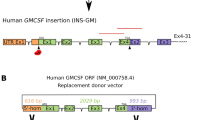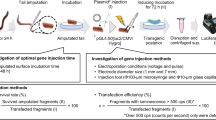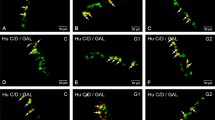Abstract
We have developed transgenic mouse models to determine whether endogenous expression of phytase transgenes in the digestive tract of monogastric animals can increase the bioavailability of dietary phytate, a major but indigestible form of dietary phosphorus. We constructed phytase transgenes composed of the appA phytase gene from Escherichia coli regulated for expression in salivary glands by the rat R15 proline-rich protein promoter or by the mouse parotid secretory protein promoter. Transgenic phytase is highly expressed in the parotid salivary glands and secreted in saliva as an enzymatically active 55 kDa glycosylated protein. Expression of salivary phytase reduces fecal phosphorus by 11%. These results suggest that the introduction of salivary phytase transgenes into monogastric farm animals offers a promising biological approach to relieving the requirement for dietary phosphate supplements and to reducing phosphorus pollution from animal agriculture.
This is a preview of subscription content, access via your institution
Access options
Subscribe to this journal
Receive 12 print issues and online access
$209.00 per year
only $17.42 per issue
Buy this article
- Purchase on Springer Link
- Instant access to full article PDF
Prices may be subject to local taxes which are calculated during checkout




Similar content being viewed by others
References
Jongbloed, A.W. & Lenis, N.P. Environmental concerns of animal manure. J. Anim. Sci. 76, 2641–2648 (1998).
Hudson, J.J., Taylor, W.D. & Schindler, D.W. Phosphate concentrations in lakes. Nature 406, 54–56 (2000).
Mallin, M.A. Impacts of industrial animal production on rivers and estuaries. Am. Scientist 88, 26–37 (2000).
Naqvi, S.W. et al. Increased marine production of N2O due to intensifying anoxia on the Indian continental shelf. Nature 408, 346–349 (2000).
Delgado, C.L., Rosegrant, M.W., Steinfeld, H., Ehui, S. & Courbois, C. The coming livestock revolution. Choices 14, 40–44 (1999).
Tilman, D. Global environmental impacts of agricultural expansion: the need for sustainable and efficient practices. Proc. Natl. Acad. Sci. USA 96, 5995–6000 (1999).
Reddy, N.R., Sathe, S.K. & Salunkhe, D.K. Phytates in legumes and cereals. Adv. Food Res. 28, 1–92 (1982).
Murry, A.C., Lewis, R.D. & Amos, H.E. The effect of microbial phytase in a pearl millet–soybean meal diet on apparent digestibility and retention of nutrients, serum mineral concentration, and bone mineral density of nursery pigs. J. Anim. Sci. 75, 1284–1291 (1997).
O'Quinn, P.R., Knabe, D.A. & Gregg, E.J. Efficacy of Natuphos in sorghum-based diets of finishing swine. J. Anim. Sci. 75, 1299–1307 (1997).
Golovan, S., Wang, G., Zhang, J. & Forsberg, C.W. Characterization and overproduction of the Escherichia coli appA encoded bifunctional enzyme that exhibits both phytase and acid phosphatase activities. Can. J. Microbiol. 46, 59–71 (2000).
Lim, D., Golovan, S., Forsberg, C.W., & Jia, Z. Crystal structures of Escherichia coli phytase and its complex with phytate. Nat. Struct. Biol. 7, 108–113 (2000).
Leeson, S., Namkung, H., Cottrill, M. & Forsberg, C.W. Efficacy of new bacterial phytase in poultry diets. Can. J. Anim. Sci. 80, 527–528 (2000).
Tu, Z.J. et al. Isoproterenol/tannin-dependent R15 expression in transgenic mice is mediated by an upstream parotid control region. Gene Expr. 3, 289–305 (1993).
Laursen, J. & Hjorth, J.P. A cassette for high-level expression in the mouse salivary glands. Gene 198, 367–372 (1997).
Chi, T.H. & Crabtree, G. R. Perspectives: signal transduction. Inositol phosphates in the nucleus. Science 287, 1937–1939 (2000).
Brown-Grant, K. Enlargement of salivary gland in mice treated with isopropylnoradrenaline. Nature 191, 1076–1078 (1961).
Zhang, J.X., Krell, P.J., Phillips, J.P. & Forsberg, C.W. Expression of a bacterial endo (1-4)-β-glucanase gene in mammalian cells and post translational modification of the gene product. Biochim. Biophys. Acta 1357, 215–224 (1997).
Plaut, K. et al. Lysostaphin expression in mammary glands confers protection against staphylococcal infection in transgenic mice. Nat. Biotechnol. 19, 66–70 (2001).
Murray, J.D. Genetic modification of animals in the next century. Theriogenology 51, 149–159 (1999).
Ward, K.A. Transgene-mediated modifications to animal biochemistry. Trends Biotechnol. 18, 99–102 (2000).
Ebino, K.Y., Yoshinaga, K., Saito, T.R. & Takahashi, K.W. A simple method for prevention of coprophagy in the mouse. Lab. Anim. 22, 1–4 (1988).
Kemme, P.A., Radcliffe, J.S., Jongbloed, A.W. & Mroz, Z. Factors affecting phosphorus and calcium digestibility in diets for growing-finishing pigs. J. Anim. Sci. 75, 2139–2146 (1997).
Scheiffele, P. & Füllekrug, J. Glycosylation and protein transport. In Molecular trafficking. (ed. Bernstein, P.) 27–36 (Portland Press, London, UK; 2000).
Corring, T. Endogenous secretions in the pig. In Current concepts of digestion and absorption in pigs. (eds. Low, A. G. & Partridge, I. G.) 136–150 (National Institute for Research in Dairying, Reading, UK; 1980).
Mikkelsen, T. R. et al. Tissue-specific expression in the salivary glands of transgenic mice. Nucleic Acids Res. 20, 2249–2255 (1992).
Smith, L.C., Bordignon, V., Babkine, M., Fecteau, G. & Keefer, C. Benefits and problems with cloning animals. Can. Vet. J. 41, 919–924 (2000).
Westhusin, M. & Piedrahita, J. Three little pigs worth the huff and puff? Nat. Biotechnol. 18, 1144–1145 (2000).
Kozak, M. At least six nucleotides preceding the AUG initiator codon enhance translation in mammalian cells. J. Mol. Biol. 196, 947–950 (1987).
Hogan, B., Costantini, F. & Lacy, E. Manipulating the mouse embryo. (Cold Spring Harbor Laboratory Press, Cold Spring Harbor, NY; 1986).
Zhang, J.X., Meidinger, R., Forsberg, C.W., Krell, P.J. & Phillips, J.P. Expression and processing of a bacterial endoglucanase in transgenic mice. Arch. Biochem. Biophys. 367, 317–321 (1999).
Church, G.M. & Gilbert, W. Genomic sequencing. Proc. Natl. Acad. Sci. USA 81, 1991–1995 (1984).
Towbin, H., Staehelin, T. & Gordon, J. Electrophoretic transfer of proteins from polyacrylamide gels to nitrocellulose sheets: procedure and some applications. Proc. Natl. Acad. Sci. USA 76, 4350–4354 (1979).
Rushmore, T.H. et al. Purification and characterization of P-52 (glutathione S-transferase-P or 7-7) from normal liver and putative preneoplastic liver nodules. Cancer Res. 48, 2805–2812 (1988).
Canadian Council on Animal Care. Guide to the care and use of experimental animals, Vol. 1. (Canadian Council on Animal Care, Ottawa, ON, Canada; 1980).
Hu, Y., Nakagawa, Y., Purushotham, K.R. & Humphreys-Beher, M.G. Functional changes in salivary glands of autoimmune disease-prone NOD mice. Am. J. Physiol. 263, E607–E614 (1992).
Harlow, E. & Lane, D. Antibodies: a laboratory manual. (Cold Spring Harbor Laboratory Press, Cold Spring Harbor, NY; 1988).
Jia, Z., Golovan, S., Ye, Q. & Forsberg, C.W. Purification, crystallization and preliminary X-ray analysis of the Escherichia coli phytase. Acta Crystallogr. D 54 (Pt 4), 647–649 (1998).
Engelen, A.J., van der Heeft, F.C., Randsdorp, P.H. & Smit, E.L. Simple and rapid determination of phytase activity. J. AOAC Int. 77, 760–764 (1994).
Nesterenko, M.V., Tilley, M. & Upton, S.J. A simple modification of Blum's silver stain method allows for 30 minute detection of proteins in polyacrylamide gels. J. Biochem. Biophys. Methods 28, 239–242 (1994).
Association of Official Analytical Chemists (AOAC). Official methods of analysis of the Association of Official Analytical Chemists. (Association of Official Analytical Chemists, Washington, DC; 1984).
Acknowledgements
The -10R15/ CAT plasmid was kindly provided by Dr. D.K. Ann (University of Southern California, USA) and Lama 2 vector by Dr. J. Laursen and Dr. J.P. Hjorth (University of Aarhus, Denmark). We thank Roy Meidinger, Tania Archbold, Dr. Ming Fan, and staff of the Central Animal Facility for expert technical assistance. This research was supported by funds from Ontario Pork and the Natural Science and Engineering Research Council of Canada awarded to C.W.F. and J.P.P.
Author information
Authors and Affiliations
Corresponding authors
Rights and permissions
About this article
Cite this article
Golovan, S., Hayes, M., Phillips, J. et al. Transgenic mice expressing bacterial phytase as a model for phosphorus pollution control. Nat Biotechnol 19, 429–433 (2001). https://doi.org/10.1038/88091
Received:
Accepted:
Issue Date:
DOI: https://doi.org/10.1038/88091
This article is cited by
-
Engineered phytases for emerging biotechnological applications beyond animal feeding
Applied Microbiology and Biotechnology (2019)
-
Transgenic pigs expressing β-xylanase in the parotid gland improve nutrient utilization
Transgenic Research (2019)
-
Production of functional human nerve growth factor from the saliva of transgenic mice by using salivary glands as bioreactors
Scientific Reports (2017)
-
Improvement of anti-nutritional effect resulting from β-glucanase specific expression in the parotid gland of transgenic pigs
Transgenic Research (2017)
-
Analysis of weighted co-regulatory networks in maize provides insights into new genes and regulatory mechanisms related to inositol phosphate metabolism
BMC Genomics (2016)



